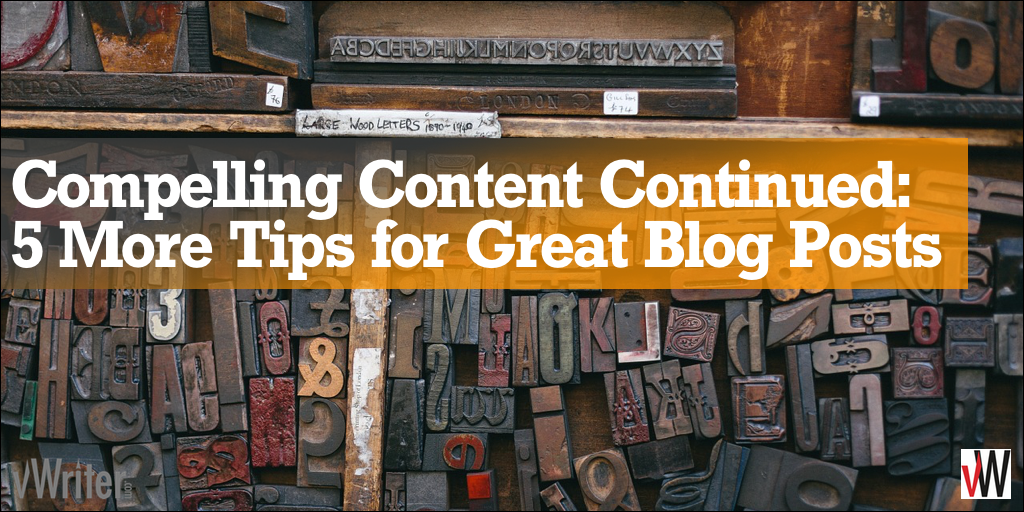Well, guess what? There are 10 tips in all – I covered 5 last time, and will cover the rest here.
As a quick recap, here are the first 5 tips for great blog posts:
- Provide practical and useful information that improves the life of the reader.
- The post is long enough to provide the required information.
- The writing allows the reader to connect with the writer.
- Provide clear and explicit instructions on how the reader should apply the information provided.
- Your blog post’s title should be catchy and clearly identify a topic of interest for the type of reader you want to attract.
So let’s go through the rest of the tips. Incorporate as many as you can into each new blog post to make your content as compelling as possible!
 The Blog Post Should Have A Convincing Opening Paragraph
The Blog Post Should Have A Convincing Opening Paragraph
Similar to writing sales letters, the purpose of the headline is to lead to the first paragraph; the purpose of the first paragraph is to lead to the second; and so on. You need to keep the reader engaged and on your page for as long as possible … or at least until they take a call-to-action within the post.
So your first, opening paragraph has a vital role to play. It sets the scene for the rest of your post. It confirms to the tentative visitor they are in the right place; or perhaps makes them decide to click away for something that suits their needs better.
Generally your first paragraph expands on the title, and outlines in more detail what the rest of your post contains. It should contain just enough intrigue to hook the reader’s interest and encourage them to read further.
Think about a trailer for a great movie, or for the next episode of a program you love watching. It’s designed to hook you in and convince you to watch it. Your opening paragraph should follow the same concept.
 The Information Should Be Communicated Clearly And Concisely
The Information Should Be Communicated Clearly And Concisely
Why use ten words when just one will do?
The Internet is all about easy to consume, quick to scan information. If you’re too wordy and difficult to understand, your reader will become quickly distracted, switch off and head elsewhere. Simplicity is best, so follow the KISS rule: “Keep It Simple, Stupid”.
Reduce the length of your sentences where possible. Use short and concise paragraphs for easy online reading. Avoid jargon. Try running the text through a Flesch-Kincaid readability checker to make it as accessible as possible.

Run your text through a readability checker to help ensure your content is easy to read.
 Avoid Making The Blog Post Too Technical
Avoid Making The Blog Post Too Technical
Obviously it depends on your niche. If you want to attract the technically-savvy, you may have to adjust this tip accordingly. But generally you want to write in a way that a beginner would benefit from.
You don’t have to go into huge amounts of technical detail on a topic in order for it to be helpful. Instead, you can link to other resources (including on your own blog) for the reader to drill down into if they want to. Providing such resources through your blog adds a lot of value in itself.
So avoid industry-specific jargon that only experts understand. Write for the newcomer.
 Provide New Information – Or Present It In A Unique Way For The Reader
Provide New Information – Or Present It In A Unique Way For The Reader
There’s precious little brand ‘new’ information. But you can present it in a way that it comes across as new, or unique in the way that you present it for the reader.
Personalize it, relate it to your own experiences and expertise, use your own voice and style, make it relate directly to the type of reader you want to attract.
Think about the additional value you can add to the information that’s already available elsewhere:
- Can you present the information from a different angle that would make it particularly compelling for your own niche?
- Can you relate it to stories you can tell?
- Perhaps you can tie it in with current news events or the time of year that would increase its relevance? (Note this tip should be kept for occasional use – you should aim for the majority of your posts to be ‘evergreen’ content that maintains its relevance over time).
 Make Your Blog Post Visually Engaging
Make Your Blog Post Visually Engaging
This tip wasn’t in the original blog post (see first paragraph) at all, and for good reason. Free reprint articles – on which that post was based – are generally a text-only medium. But blog posts are very different and allow you to take full advantage of rich media.
Readers are turned off by a page full of heavy text. They are used to the fast-paced and visually rich environment of social media, and want something more visually engaging that will hold their attention and stimulate their interest in multiple ways.
So, for a compelling blog post, you need to incorporate media such as images, videos, and other visual enhancements to help the reader flow down your page and become immersed in your content.
This starts with your Featured Image – you can see the one for this post right at the top. As shown in the Be Everywhere Blueprint, this image is then reused and adds value in lots of different ways to build your online visibility and authority.
You should also include other visual enhancements throughout your post. Here are some ideas:
- Use photographs or other images to help illustrate your points.
- Create a Slideshare presentation or video based on your post – once published, embed it into your post (see example).
- Use the Tweet This WordPress plugin or similar to break up the text and provide opportunities for readers to share your information on Twitter (see examples above).
- Adjust the stylesheet for your blog so that lines are well spaced apart, the font is easy to read and there are well-sized gaps between paragraphs (ask your webmaster to help with this one).
- As I’ve done in this post, try using graphical numbers rather than straight text for list-type articles.
- Use bullet points to make your information easy to scan and absorb.
Anything I’ve missed? What do you find particularly compelling with a blog post that makes you want to stay and read more?





I have gotten pretty good at blogging and your tips are great.